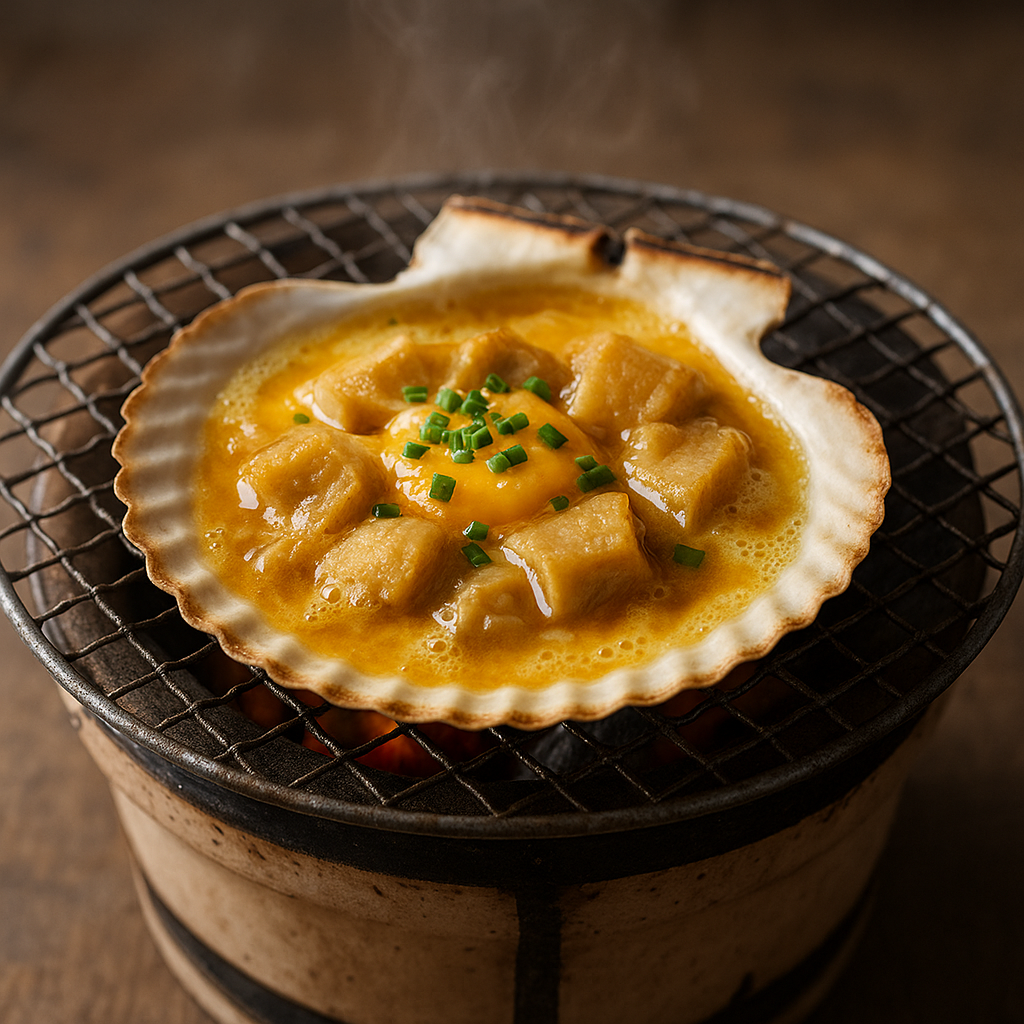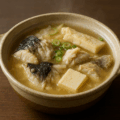貝焼き味噌の特徴
ホタテの貝殻を鍋代わりにする青森の郷土味
貝焼き味噌は、ホタテの貝殻を器兼フライパンに見立て、味噌と出汁、卵などを加えて直火で煮固める青森の郷土料理。貝の旨みと味噌の香りが一体となり、朝の一皿や酒肴として親しまれます。
ふんわり卵と味噌だれの調和
出汁でのばした味噌に卵を落としてやさしく火を入れ、半熟~ふんわりに仕上げるのが基本。ねぎや豆腐、きのこを加えると食べ応えが増します。
貝殻ならではの香ばしさ
直火で温めた貝殻がほどよく熱を伝え、縁に香ばしい焼き目がつくのが魅力。卓上コンロやグリルで手軽に楽しめます。
貝焼き味噌のレシピ
材料(2枚分/小ぶりのホタテ殻2枚使用)
- 卵 … 2個
- 木綿豆腐 … 100g(1.5cm角)
- 味噌 … 大さじ2(好みで赤・合わせ)
- みりん … 大さじ1
- 酒 … 大さじ1
- (お好みで)砂糖 … 小さじ1/2
- ネギ…適量
作り方
- 下準備:貝殻はよく洗って乾かす(耐熱の小鍋や小さなスキレットでも可)。だし・味噌・みりん・酒・(砂糖)を混ぜて味噌だれを作る。
- 煮る:貝殻を弱〜中火にかけ、味噌だれを半量ずつ注ぐ。豆腐を分け入れ、軽く煮立てる。
- 卵を落とす:それぞれに卵を1個ずつ割り入れ、白身が固まり始めたら火を弱める。お好みの半熟〜ふんわりになるまで火入れ。
- 仕上げ:好みでバターをひとかけ、七味を少々。火から外し、熱いうちにいただく。
シェフのワンポイントアドバイス
卵は加えたら弱火でやさしく。煮詰まりすぎたらだしを少量足して濃度を調整。
貝殻が不安定なときはアルミホイルで形を作ってから乗せると安心できます。
本来はホタテを入れませんが、入れたほうが美味しいです。
卵は溶き卵でもそのまま形を残してもお好みで構いませんよ。
栄養価(1枚分の目安)
- エネルギー:約180〜260 kcal(バター使用で+40〜70 kcal)
- たんぱく質:18〜24 g
- 脂質:6〜12 g
- 炭水化物:6〜10 g
- ビタミンB群・亜鉛(ホタテ由来)/ヨウ素(だし)
高たんぱくで比較的低脂質。塩分は味噌量で調整しましょう。
歴史
漁師町の“殻鍋”から生まれた一品
道具の少ない漁場でも調理できるよう、手元の貝殻を鍋代わりにしたのがはじまり。味噌と卵で温かな一皿に仕立て、朝食や酒肴として受け継がれてきました。
家庭と食堂で親しまれる青森の味
陸奥湾や下北・津軽沿岸のホタテ文化と結びつき、旅館や食堂の定番に。豆腐・きのこ・ねぎなど身近な具材で四季を問わず楽しめます。
English Version
Features of Kaiyaki Miso
An Aomori Classic Cooked in a Scallop Shell
Kaiyaki miso treats a scallop shell as both pan and serving dish. Miso thinned with dashi and an egg are gently set over direct heat. Shell umami and miso aroma fuse into a dish enjoyed for breakfast or with drinks.
Harmony of Fluffy Egg and Miso Sauce
Eggs are poached in a lightly seasoned miso–dashi base to a soft or fluffy set. Negi, tofu, and mushrooms add substance.
Shell-Fired Aroma
Heating in the shell gives a gentle scorch around the rim and a distinctive toasted fragrance. A tabletop burner or grill works well at home.
Recipe
Ingredients (for 2 shells / using two small scallop shells)
- Eggs … 2
- Firm tofu … 100 g (1.5 cm cubes)
- Miso … 2 tbsp (red or blended, to taste)
- Mirin … 1 tbsp
- Sake … 1 tbsp
- (Optional) Sugar … 1/2 tsp
- Negi (scallion) … to taste
Instructions
- Prep: Wash and dry the shells well (a small heatproof pan or mini skillet also works). Combine dashi, miso, mirin, sake, and (if using) sugar to make the miso base.
- Simmer: Set shells over low–medium heat and pour in half the miso base into each. Add tofu and bring just to a gentle simmer.
- Add eggs: Crack 1 egg into each shell. When the whites begin to set, lower the heat and cook to your preferred softness.
- Finish: Add a small knob of butter and a pinch of shichimi if you like. Remove from heat and serve hot.
Chef’s Tip
Once the eggs go in, keep the heat low and gentle. If the sauce reduces too far, add a splash of dashi to adjust thickness. If shells wobble, set them on a cradle of aluminum foil for safety. Traditionally no scallop meat is added, but adding it makes the dish tastier. Use either beaten eggs or leave them whole—your call.
Nutritional Value (per shell, approx.)
- Calories: 180–260 kcal (add 40–70 kcal if using butter)
- Protein: 18–24 g
- Fat: 6–12 g
- Carbohydrates: 6–10 g
- B vitamins & zinc (from scallops) / Iodine (from dashi)
High protein and relatively low fat. Adjust saltiness by the amount of miso.
History
A “Shell-Pot” Born in Fishing Towns
With few tools at sea, cooks used shells as pans. Miso and egg made a warming one-dish meal that became a breakfast staple and sake companion.
An Aomori Taste Loved at Home and in Eateries
Tied to the scallop culture of Mutsu Bay and the Shimokita/Tsugaru coasts, it’s now a fixture at inns and diners, enjoyed year-round with tofu, mushrooms, and negi.



何でも質問してください!